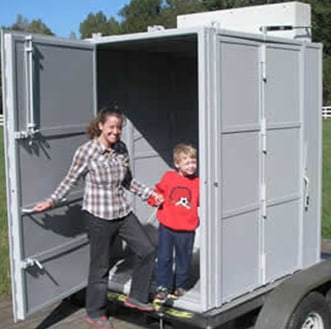The FEMA guidelines for Tornado protection are numerated in FEMA P-361, Design and Construction Guidance for Community Safe Rooms, Second Edition, August 2008. Paragraph 8.10, entitled Standby Power on page 8-12 states: “The ICC-500 standard requires standby power systems to be designed to provide the required output capacity for a minimum of 2 hours and to support the mechanical ventilation system, when applicable.”
Another US government agency, Centers for Disease Control and Prevention in their Natural Disasters and Severe Weather – Tornado section stated: “Injury may result from the direct impact of a tornado, or it may occur afterward when people walk among debris and enter damaged buildings. A study of injuries after a tornado in Marion, Illinois, showed that 50 percent of the tornado-related injuries were suffered during rescue attempts, cleanup, and other post-tornado activities. Nearly a third of the injuries resulted from stepping on nails. Other common causes of injury included falling objects and heavy, rolling objects. Because tornadoes often damage power lines, gas lines, or electrical systems, there is a risk of fire, electrocution, or an explosion. Protecting yourself and your family requires promptly treating any injuries suffered during the storm and using extreme care to avoid further hazards.”
The VAST6 by BIG 6 LLP will provide the protection to survive the initial direct hit of a tornado. The standard 2-hour Standby Power would be adequate for a storm or series of storms to pass through the area but not make a direct hit or even minor damage to facilities. The VAST6 has a back-up battery system is designed to support lighting and ventilation for 12 to 24 hours. There is a massive amount of debris in the area and a clear path is probably not readily available. The Standard Operating Procedures, developed before an event, should state the occupants will remain in the VAST6 until first responders/safety crews indicate it is safe to evacuate. The evacuation should be orderly, probably single file, led by first responder to a safe assembly area. Think of the clearing of the path through a tornado debris field similar to the military clearing a path through a minefield. The clearing of the path will take some extra time, but the VAST6 occupants have survived the initial tornado event and can wait the extra time it takes for the path to be cleared, decreasing their chances of injuries.
After an Active Shooter event, the same concept of remaining in the VAST6 but for slightly different reasons. After the initial active shooter has been captured or neutralized, law enforcement would like the extra time to thoroughly sweep the area once more for any unrealized victims or any left-behind devices to ensure the area is positively secured. The area of the event is now an active crime scene that must be processed professionally. This means walking students out of the VAST6 near this scene is not ideal. If an individual was wounded during the event and dragged to safety by law enforcement, there may be a large blood smear on the floor. If an individual is dead, the body remains there for a few more hours. Cartridge or shell casings along with firearms must be recorded in their exact location and cataloged as part of the crime scene processing. The supervisor of the crime scene will probably demand that students and teachers departing the area will not move through the crime scene or if possible, not even observe the crime scene. First responders could put up partitions or screens to block the view and, again determine a path around the area, similar to clearing a path through debris from a tornado.
For these reasons, the VAST6 has a back-up battery system is designed to support lighting and ventilation for 12 to 24 hours while occupants await for a clear path.




